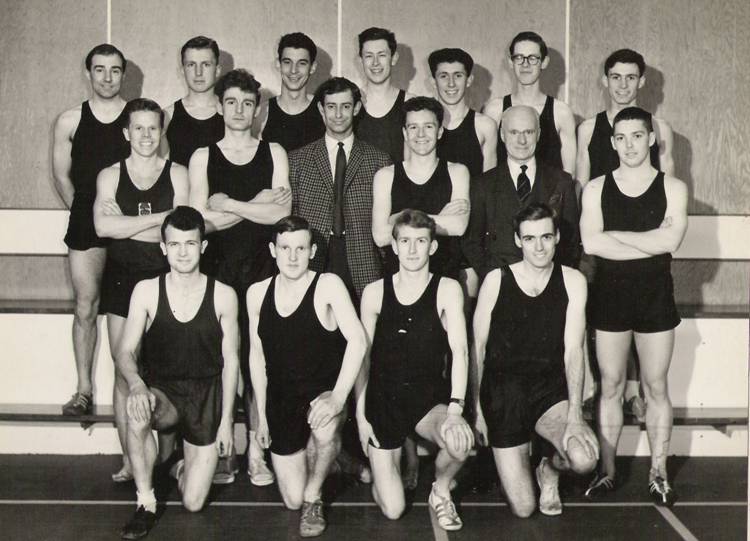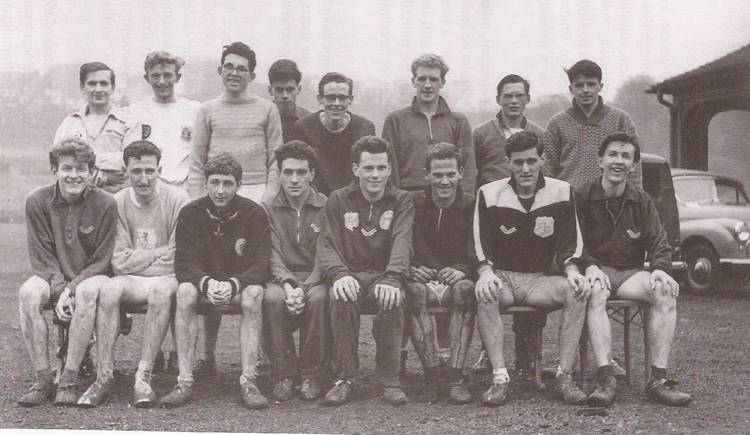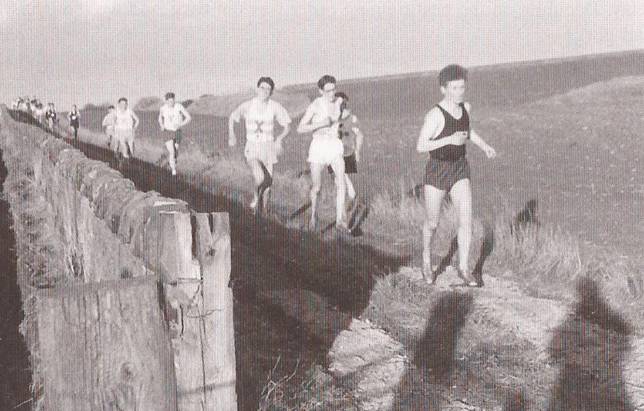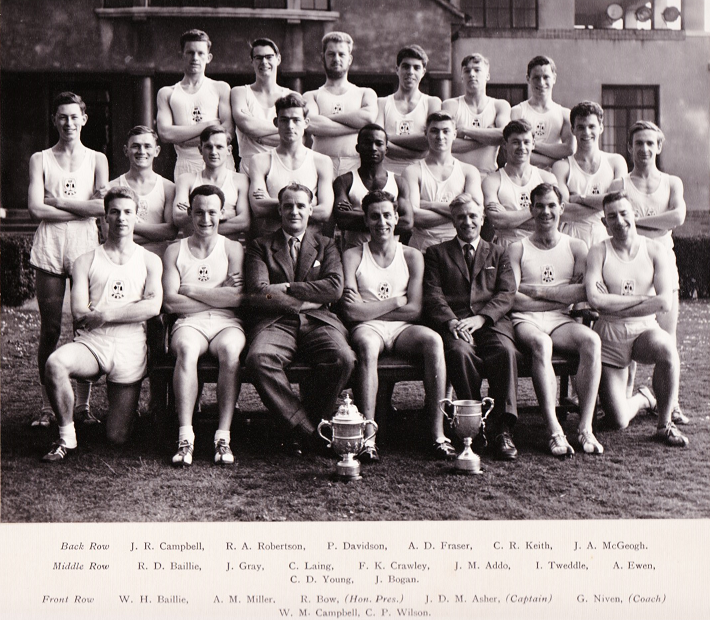Back Row: Ray Baillie in the middle and Nick Rogers second from the left
Second Row: Tor Denstad, Terry Kerwin, Craig Sharp, Brian Scobie, Willie Diverty, Brian Kennedy
Front Row: Allan Faulds, Calum Laing, Dick Hartley and Cameron Shepherd
It is unusual for any University team to make it to the top in team competition for many reasons. First there is the regular turnover of students as they arrive and graduate. There was a time when the ‘chronic’ was a feature in every university – the student who went on either doing degree after degree and never working for a living, but these days are gone. Second a habit seems to be developing, or have developed for students, after graduation, moving to another establishment for their PhD and increasingly they are leaving the country. Third we have a situation where many, if not most, students continue to represent their clubs while studying rather than temporarily transfer allegiance to the University team. Rumour has it that Bobby Calderwood of VPAAC was one of the very first to keep on racing for his club team during his student days, and certainly when Glasgow University won the ScotUnis eight times in succession in the 80’s several prominent members only ran for them in Scottish or British University competition while competing against them for the rest of the year. It is therefore not all that common for any University squad to reach the heights.
When we talk of good University teams the immediate point of reference is the great Edinburgh University runners who won the Edinburgh to Glasgow Relay three times in the late 60’s and were running well right into the 70’s. But before their heyday, the Glasgow University team was hailed as the best ever Scottish University team. Several very good runners just happened to appear at the same time, to prefer to run for GUAC or GU Hares and Hounds and to enjoy each other’s company. The names fondly remembered by those who saw them come easily to mind: in alphabetical order they were Ray Baillie, Jim Bogan, Tor Denstad, Allan Faulds, Douglas Gifford, Calum Laing, Nick Rogers, Cameron Shepherd, Brian Scobie, and several others. Allan Faulds will be profiled on the ‘Elite Endurance’ page of this website and it would maybe be appropriate to look at some of the other members of this group first before taking the team as a whole. By the way, if anyone has more names for the photograph above, would they let me know?
Calum Laing was undoubtedly the top endurance runner for his brief time at University and it is a real pity that he did not carry on with his career after graduation. He was a son of the manse from Ross-shire who appeared in the 1960 National Cross Country Championship as one of only two seniors entered by Inverness Harriers when he finished down the field in sixty second place. In two short years he moved up to third place when representing Glasgow and leading the team (Laing 3, Gifford 27, Hartley 38, Rodgers 67, Denstad 123 and Campbell 146) to third place. The quality of this run can be seen from the names of the first eight finishers – Jim Alder, Andy Brown, Calum Laing, Steve Taylor, Alastair Wood, Bertie Irving, John McLaren and John Linaker. His reward was a run in the International Cross-Country Championship where he was a scoring runner in thirty seventh position. The country was his real forte and in 1963 he again made the team for the International Championship and was again a counting runner, finishing in sixty third place. In the National in 1964 he was eighth, his second best placing, and the team was fourth. An inspiration, he had several very good runs in the Edinburgh to Glasgow Road Race. In 1960 he raced the second stage and picked up from twelfth to fourth for the team that was to pick up the bronze medals. A year later he again ran the second stage and pulled the team from fifteenth to twelfth on this very difficult leg with second quickest run of the day but the following year, 1962, he ran even better bringing the team from fourth to first with the fastest time for the leg.
1962 was to be his best year on the track with four personal best times which are noted below. That for the Six Miles was set when winning the SAAA championship, (he had already won the West District Six Miles) and the Three Miles time was set when he was third in the District championships, he was also third in the National Three miles. So – two first places and two third places. Many of his team-mates and rivals thought that he could have been an Olympian but unfortunately he had a short career before leaving University.
| Distance | Time | Year | Ranking |
| One Mile | 4:15.0 | 1962 | 12 |
| Two Miles | 9:12.4 | 1962 | 8 |
| Three Miles | 14:01.6 | 1962 | 4 |
| Six Miles | 29:53.8 | 1962 | 3 |
When his University days were over he ran for Victoria Park. Nationally he ran in two Edinburgh to Glasgow Relays and one National winning medals in two out of the three. In the E-G in 1965 he ran on the fifth stage for the team which was third, turning in the second fastest time. In 1968 he ran in the last stage, taking over fourth and holding it to the finish. In the National in 1966, he was thirty second in the team that took silver.
In his official history of the SCCU, “Whatever the Weather”, Colin Shields says in his review of the 1962 Cross-Country Championship, ’24 year old agricultural student Calum Laing, a son of the manse from the North of Scotland studying at Glasgow University, was the best distance runner produced by any Scottish university to date.’
UAU team (in front) and the SUCC team at Durham, 1960: Jim Bogan on the left in the back row, Don Macgregor third from left.
Picture from Don Macgregor’s “Running My Life”
Jim Bogan stayed as part of the University faculty after he graduated and became “one of Britain’s leading figures in veterinary medicine.” A member of Victoria Park AAC (as indeed was Calum Laing) he was a steeplechaser during the track season and when Lachie Stewart set the SAAA 3000m steeplechase title, Jim was one of the early pacemakers. The steeplechase was to prove his best event and he was ranked among the top men in the event almost every year in which he competed seriously with a best of 9:40.4 in 1966. His best Mile time was 4:18.2 and for Three Miles he is credited with 14:55.0 in 1960.
In 1960 Jim in thirteenth place led the University Junior team to third place in the National Cross-Country Championship. He was followed home by Hunter (16), Gifford (27) and Hartley (28). He joined some of the men who would make up the really good team of later years and which was second in the Scottish Junior Cross-Country Championships in 1961. Douglas Gifford (9), Bogan (13), Baillie (22) and Shepherd (23) were the counting runners. In his third year in the Junior age group he was in the team which won the Junior championship giving him the complete set of gold, silver and bronze for the National team race. The runners that day were Allan Faulds (4), Jim Bogan (5), Cameron Shepherd (16) and Ray Baillie (23).
In the Edinburgh to Glasgow relay in 1959 he was ninth on the first stage for the team that finished thirteenth. In 1960, he ran on the first stage for the team that was placed third – he was twelfth on the first stage before Calum Laing brought the University up to fourth, from which position the others worked their way up to third. In 1961 he was fourth fastest on the third stage, bringing the team from twelfth to sixth – six places was really something in the E-G. When the University team was third in the Edinburgh to Glasgow in 1962, Jim Bogan ran on the third stage again and although dropping one place it was from first to second after Calum Laing’s fastest time on Stage Two, so there was no disgrace in that! In 1963 he ran the last stage and picked up one place from seventh to sixth with again the fourth fastest of the afternoon. By 1964, many of the top men had moved on but Jim was still there, running the last stage he maintained fifteenth position. No fair weather runner he was out for the team again in 1966 running the very difficult second stage and held on to seventeenth place. By 1967 the team had slumped to nineteenth and Jim ran the seventh stage picking up from twentieth to nineteenth. That was to be his last run in the race.
He stayed on as a member of the staff of the University and became President of the University Hares & Hounds. In that capacity he was responsible for many innovations – the key one being the University Road Race every year in November. He stayed as a member of Victoria Park too as a recreational runner and it came as a shock to us all when he died following a road accident while on holiday in Grenoble in July 1988. An excellent athlete, he was very easy to get on with and was popular with all athletes regardless of club or generation. He was a runner first and foremost and runners always know their own.
Douglas Gifford was a very good athlete who, like many University athletes of the period, just seemed to stop competitive running when his student days were over. A key member of this excellent team, he excelled in student matches and championships, and showed great ability in open competition. In the National Championships, Douglas appears in the 1959 Glasgow University team when his twenty fifth place headed the four counting men to fifth place. In 1960 he was twenty seventh and third scoring runner in the Junior team that finished third and one year later his ninth place led the team to silver in the National championship. Unfortunately he was a year out of sync with Jim Bogan and moved up to the senior ranks and by so doing missed the gold Junior medals of the following year. Nevertheless he was twenty seventh in his first Senior National behind Calum Laing’s third place. The team was eighth. Unfortunately, despite all his good running, he was not a member of the team that was placed fourth in 1964. He continued to run for the University from time to time but by 1966 the team had broken up – Calum Laing was running for Victoria Park in the National , Allan Faulds for Stirling and Dick Hodelet for Greenock Glenpark Harriers while Douglas was fiftieth running in the University colours.
His record in the E-G covers the same period. In 1959, in his first run in the event, he was on the second stage – seldom a good idea for a first run in that event – and did well to limit the drop to four places. In 1960, he was given a job which might even have been slightly more difficult – taking over in fourth place on the sixth stage surrounded by top class athletes. He kept the position and the team was third at the end of the race. In 1960 he was again on the Stage Six and held the sixth place that he had been given by Dick Hartley. 1962 brought him another bronze medal. This time he was on the fourth stage and ran the third fastest time on the stage to hand over in second place for the team which eventually finished third. In 1964, the team lost several members and in the E-G Glasgow University finished fifteenth with Douglas back on the sixth stage.
In the picture below he is seen leading the 1960 Scottish Universities Championships which he won with Glasgow winning the team race. It is described in Don Macgregor’s autobiography “Running My Life”, from which the photograph was taken, as follows: “Our hopes of recording an historic victory in the Scottish Universities Championships the next Saturday, February 6th, were high. The four teams lined up outside St Salvator’s Tower in North Street. Archie Strachan and Willie Diverty, Glasgow’s “manager” and Scottish ‘Athletics Weekly’ correspondent, watched as Professor Dickie, dressed in his usual broad-brimmed black hat, black coat and suit, dropped his hankie and we were off. It was quite sunny and much drier underfoot than the week before. The individual and team struggle was intense along the Kinkell Braes, over to the A917 Crail Road, and up the big hill with its ‘plough’. St Andrews were 12 points ahead with 2 miles to go as we plummeted down from Lochend farm track over the stubble fields with the whole magnificent vista of the city and its towers laid out before us.
Alas for our hopes! The Glasgow middle counters gradually moved up the field. The two best Glasgow runners, Douglas Gifford and Jim Bogan, and I had broken away from the rest quite early on. We stayed together through the streets of the new town and were still together going up Dyers Brae into narrow Abbey Street – widened ten years later – and over South Street into South Castle Street. It was only over the last 300 yards that Gifford and Bogan were able to break away from me to take the first two places for Glasgow with five seconds covering the first three. David Jeffrey followed me home in 4th. Glasgow also took the team medals, but there were only 7 points in it.”
The extract is interesting for several reasons, the first being that the race was started by dropping a hankie. This was very common practice in road and cross country races with the old joke being about the difficulty of hearing the recall hankie in the event fo a false start. Second is the fact that it was a single lap trail – nowadays the ease of spectating plays a part and it is much more usual to have a course of two, three or even four laps. The Glasgow University home course was also one single, big, challenging lap which started at Garscadden Playing Fields went up on to the Great Western Road Boulevard past the Drumchapel Road entrance and then over the hilly fields of Braidfield and Langfaulds Farms before making its way back down the Boulevard. The officials started the race and their watches, repaired to the clubhouse for tea and elegant conversation coming back out when they estimated the first runner would appear. What is not different is the ferocity of the battle for individual and team victory.
Winner Doug Gifford in the SUCC Championships leading at three miles up to Crail Road.
Jim Bogan was second
The coming together of the team can maybe best be seen by following the fortunes of the Edinburgh to Glasgow squad. The first significant group was in the relay of November 1959 when Jim Bogan ran a fairly steady first leg to hand over in ninth place to Doug Gifford. Being new to the event and against top quality opposition he dropped to thirteenth, a position kept by Dick Hartley on teh short Stage Three. S Hunter brought them up to tenth before S Kerr and Nick Rogers dropped to thirteenth leaving Tor Denstad and J Gray to bring the team home in that position. Six of the names that would bring success to the Hares and Hounds are there. 1960 saw them win their first medals in the event. Jim Bogan again led off but was slightly lower than the previous year with twelfth place before new boy Laing brought them up to fourth with the second fastest stage of the day. His example was followed by Rogers who was second fastest on Stage Three catching another place. Hunter had third fastest but dropped a place on the fourth. Gray (seventh fastest) held it, as did Gifford on the sixth stage (fifth fastest), before Hartley brought them up to third, a position held by Denstad on the final stage. 1961 wasn’t quite so good with the team crossing the finish line in eighth. Ray Baillie had a poor first stage handing over in fifteenth, although when I say ‘poor’ you should bear in mind that it was the top twenty teams in Scotland and he was against their chosen first runners. Everything is relative! Calum again had a good second stage and turned in the second fastest time again to hand the baton over to Jim Bogan in sixth. Jim ran the fourth fastest of the stage to move up to sixth, Dick Hartley maintained it as did Cameron Shepher who had the third fastest fifth stage that year. Doug Gifford kept it on the hard and long Stage Six before Norman McPhail dropped to seventh and then Tor Denstad lost one more place to eighth. Two additions and some team shuffling by the selectors brought the team into medal winning contention again in 1962. This time Dick Hartley started the ball rolling with fourth on the first stage before Calum Laing moved into first with the fastest outing on Stage Two. Jim Bogan dropped one place but from first at the end of a close fought second, that’s no disgrace – he again had fourth fastest time of the day. Dougie Gifford ran the third quickest fourth stage to hold second before Ray Bailllie dropped one to third. This was held all the way to the finish by Allan Faulds (fourth fastest), Cameron Shepherd (second fastest and Brian Scobie on the last leg. That was the last of the really good teams and many of them graduated and moved on and the following year the squad had dropped to fifteenth in the race.
As noted above, the Junior team went from third to second to first in the National with Bogan, Hunter, Hartley, Gifford, Faulds, Shepherd and Baillie moving through. As Seniors they never seemed to reach the same heights. In 1962, Laing (third), Gifford (27th), Hartley (38th), Rodgers (67th), Denstad (123rd) and Campbell (146th) were eighth and in ’63 they failed to finish a team behind Laing, Rodgers, Hartley and Gray. 1964 was probably their best team in the senior event – Laing was eighth, Faulds fourteenth, Kerwin forty second, Shepherd forty third, Hodelet fifty seventh and Hartley sixty first – behind ESH, Aberdeen and Motherwell and ahead of Shettleston. The following year they were ninth, Ray Baillie in twenty sixth was the first finisher, Cameron Shepherd forty third ……………….. and the results thereafter have big gaps so that the rest of the team is not available and the fourth place of the year before was the best the seniors were to achieve.
GUAC, Appleton Trophy Winners, 1961
Allan Faulds provided some of the results from the Scottish Universities Cross-Country Championships between 1962 and 1964 and they are actually quite impressive.
- 1962: 1st Calum Laing; 2nd Doug Gifford; 3rd J Bogan; 7th Cameron Shepherd; 8th Allan Faulds; 13th Dick Hartley. Points total was 34 points which won the team race from Edinburgh on 45 points, St Andrews on 115 points and Aberdeen 139 points.
- 1963: 1st Calum Laing; 8th Allan Faulds; 10th Brian Scobie; 14th Tor Denstad; 15th Cameron Shepherd; 17th Ray Baillie. Points total of 65 put them second behind Edinburgh’s 53 with St Andrews on 96 and Aberdeen on 103.
- 1964: 2nd Calum Laing; 5th Allan Faulds; 6th Brian Scobie; 11th Terry Kerwin; 12th Cameron Shepherd; 13th Jim Bogan. The total of 49 points gave them a comfortable victory over Edinburgh (71) with Aberdeen third (83), St Andrews 4th (110) and the Royal College of Science and Technology (later to become Strathclyde University) fifth with 189 points.
That it was a very good team, there is no doubt. Times and marks for some of those not covered so far include: Dick Hodelet (only ranked times for 1963 and 1964 are included since he was back with Greenock Glenpark Harriers by 1995) – 880 in 1963 of 1:54.2; in 1962 he had times of 10.2 (100 yards, ranked 16th), 49.9 (440 yards, 10th) and 1:52.6 (880 yards, 2nd); Brian Scobie 1964, 880 yards in 1:55.6; 1965, 880 yards in 1:54.5. Ray Baillie 1961, 1 Mile in 4:26; ’62, 1 Mile in 4:17, 1963, Three Miles in 14:41; JB Gray 1959, Three Miles in 14:45.



